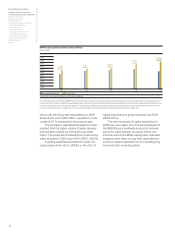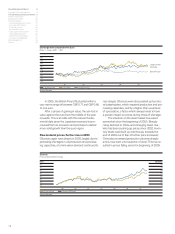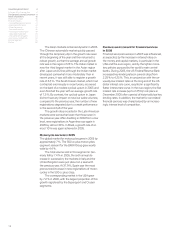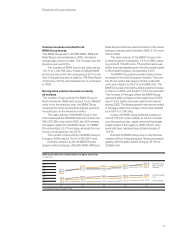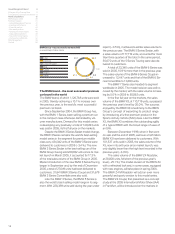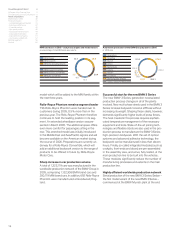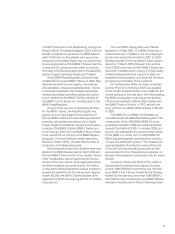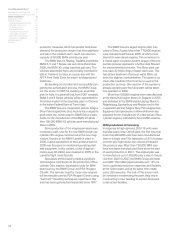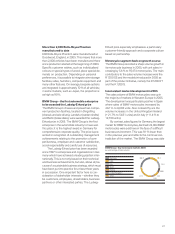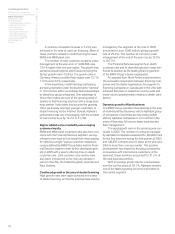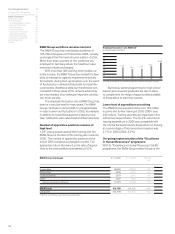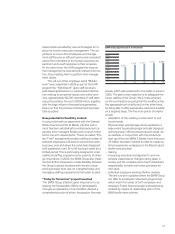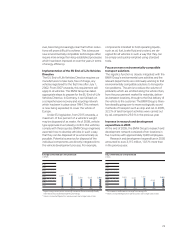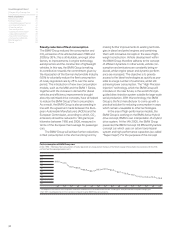BMW 2005 Annual Report Download - page 21
Download and view the complete annual report
Please find page 21 of the 2005 BMW annual report below. You can navigate through the pages in the report by either clicking on the pages listed below, or by using the keyword search tool below to find specific information within the annual report.20
economic measures which temporarily held down
demand, the production volume has now stabilised
and will, in the medium-term, reach a production
capacity of 30,000 BMW vehicles per year.
The BMW plant in Rayong,Thailand, assembles
BMW 3, 5 and 7 Series cars and, since December
2005, the BMW X3, using imported part sets. The
vehicles assembled there are primarily intended for
sale in Thailand, but also, in conjunction with the
AFTA Free Trade Zone, for export to Malaysia and
Indonesia.
By deciding on a location and successfully com-
pleting the authorisation process, the BMW Group
set the scene in 2005 for building an assembly
plant in India. It is planned that, from 2007 onwards,
BMW 3 and 5 Series vehicles will be assembled for
the Indian market at the assembly plant in Chennai
in the Indian Federal State of Tamil Nadu.
The BMW Group’s cooperation partner, Magna
Steyr Fahrzeugtechnik, Graz, Austria has a separate
production line, constructed to BMW Group’s stan-
dards, for the manufacture of the BMW X3. More
than 106,000 BMW X3 vehicles were manufactured
there in 2005.
Serial production of the magnesium-aluminium
composite crank case for the new BMW straight-six
cylinder Otto engine commenced at the new mag-
nesium foundry at the BMW Landshut plant in
2005. Capital expenditure at the Landshut plant in
2005 was focussed on modernising existing plant
and equipment. In this context, a total of approxi-
mately euro
80 million was invested in 2005 in the
Landshut
light metal foundry.
Specialists at this foundry made a significant
technological contribution to the production of four-
cylinder Otto engines developed jointly for MINI
brand cars by the BMW Group and PSA Peugeot
Citroën. The cylinder head for these new engines
will be manufactured by PSA Peugeot Citroën using
“lost foam” moulding techniques; expertise in this
area has been gathered and expanded since 1997.
The BMW Group’s largest engine plant is lo-
cated in Steyr, Austria. More than 778,600 engines
were manufactured there in 2005, of which more
than 60% were diesel engines. The conversion to
a closed water circulation system as part of the pro-
duction process represents a further step forward
for environmental protection. The Steyr plant can
now save 30 million litres of water each year. This
two-phase treatment of process water filters out
even the slightest contamination. The water is so
clean after treatment that it can be re-used in the
production process. One section of the system is
already operating and the full system will be taken
into operation in 2006.
More than180,000 engines were manufactured
at the Hams Hall engine factory in England in 2005
and delivered to the BMW plants Leipzig, Munich,
Regensburg, Spartanburg and Rosslyn and to the
cooperation partner, Magna Steyr Fahrzeugtechnik.
Equipment and processes in Hams Hall were also
prepared for the manufacture of a new series of four-
cylinder engines, intended for future MINI versions.
MINI production in full swing
In response to high demand, 200,119 units were
manufactured at the Oxford plant, the first time that
more than 200,000 units have been manufactured
there in a single year.This represents a 5.6% increase
over the very high production volume achieved in
the previous year. More than 750,000 MINI cars
have now been manufactured there since the start
of serial production in 2001. The original plan was
to manufacture up to 100,000 units a year. In the pe-
riod from 2005 to 2007, the BMW Group will invest
over GBP 100 million (approximately euro 145 mil-
lion) to optimise production capacities and flexibility
at the Oxford plant, and at the same time create
some 200 new jobs. The bulk of this amount will
be invested in modernising the paint shop and in
constructing a new building to expand bodywork
construction facilities.
Group Management Report 8
A Review of the Financial Year 8
The General Economic Environment 11
Review of operations 15
BMW Stock in 2005 38
Financial Analysis 41
--Internal Management System 41
--Earnings performance 42
--Financial position 45
--Net assets position 46
--Subsequent events report 49
--Value added statement 49
--Key performance figures 51
--Comments on BMW AG 52
Risk Management 56
Outlook 60


